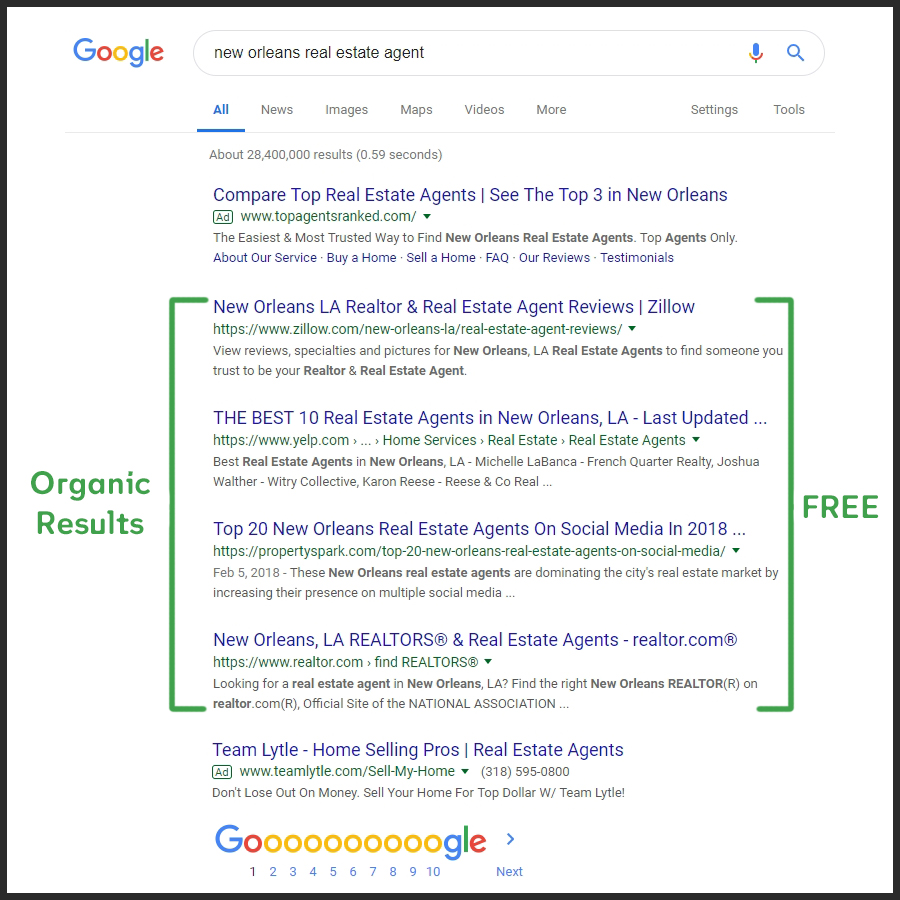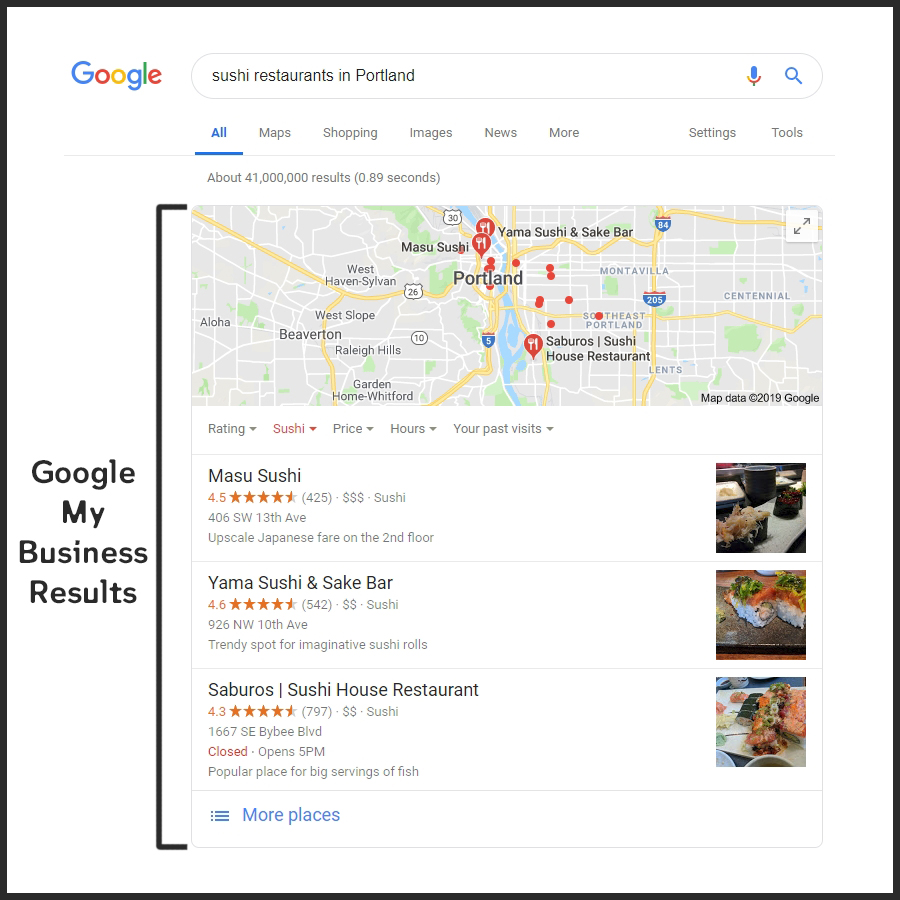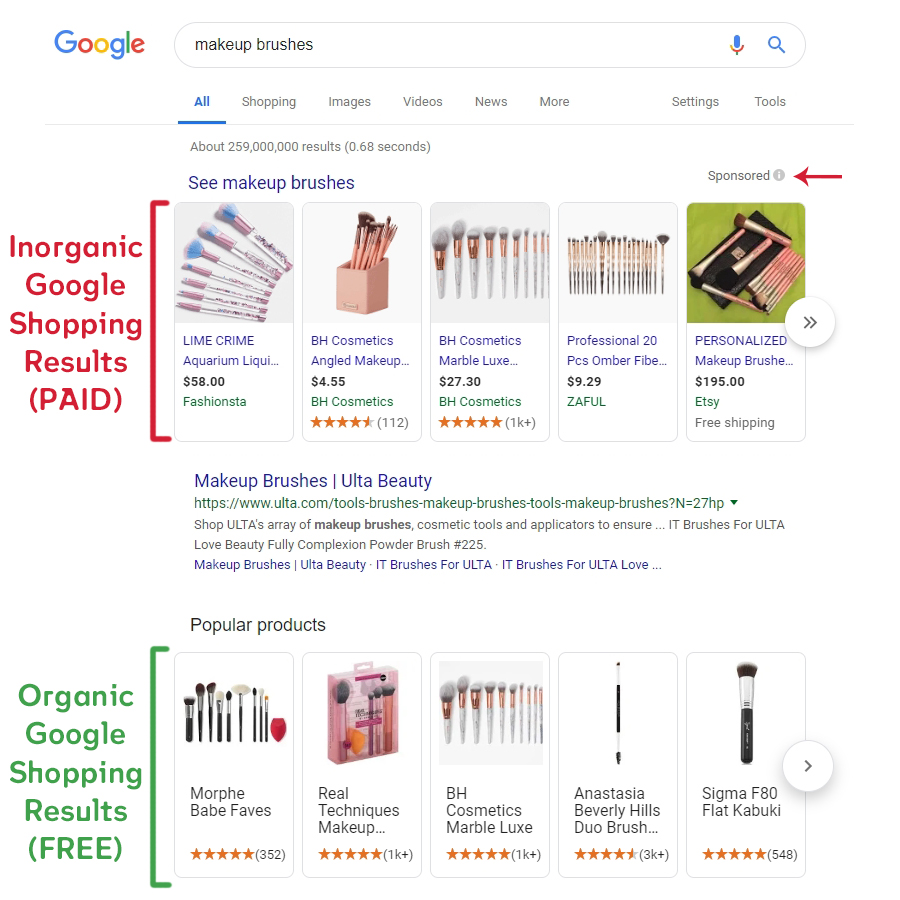Search Engine Optimization (SEO)
Search Engine Optimization (SEO) – is the ongoing process of optimizing your online presence so that your website, business, and products get ranked highly and organically in search engines for very specific keyword phrases.
Search engine optimization is absolutely necessary in order to get ranked highly in search engines and it’s amazing what a little SEO can do for your business. However, be careful of scammers, spammers, and amateurs promoting this service as there are a lot of them in this field. More on this soon, but first, let’s break down search engines and the search engine results page.
Search Engines
Search Engines Results Page (SERP)
1. Organic results (FREE) – These are the results that are the most relevant (according to Google’s algorithm) to the string of keywords used during a Google search. The higher the result, the more relative the results are supposed to be to the string of keywords searched.

Getting highly ranked organically in search engines is the ultimate goal of search engine optimization. It takes a lot of work and takes some time, but its absolutely worth it as it will pay you dividends over and over.
So you are probably thinking to yourself how you want your website, business, and/or products to be found on the first page of Google right? So does everyone else on the internet. Getting on the first page of Google organically for competitive keywords is very hard to do no matter what some SEO salesman or saleswoman tells you. However, getting on the first page of Google organically for long-tail keywords (more on this soon) is a lot more doable if you put in the extra work and target keywords that are unique and not-so-competitive. You also need to make sure that the keywords that you choose are highly relevant to your website’s content. See the keyword research section below for more information on this.

These inorganic / paid results are a great way to get found almost immediately in search engines like Google. You just have to pay Google to make this happen and this is known as setting up a Google Pay-Per-Click (PPC) campaign via Google Ads.
The way this works is that you identify the keywords that you want to be found for, then you tell Google the max dollar amount that you would be willing to pay for each time someone clicks on your ad. This dollar amount that you pay each time someone clicks on your ad is called the cost-per-click. In the Google Ads backend, you can set up a max budget, figure out what your max cost-per-click is going to be, get an estimated traffic idea, and do a bunch of other cool things. It has a decent learning curve to it, but we can help you with this or take care of this for you.
The cost of each click depends on the string of keywords that you choose to be featured for and whether or not you want to pay more to be the first result to show up. For example, if you are a CPA based out of New Orleans and you want to be the first paid result for the search term “CPA New Orleans” then you will most likely need to spend anywhere from $3.23 to $10.19 each time someone clicks on your ad. But don’t worry, you can set up a max budget in order to control your spending.
If you set up a max budget of $500 for the month using the “CPA New Orleans” example above, then you will get approximately 75 clicks to your website for that month from your paid advertisement (your PPC campaign). *Assuming a $6.71 average cost-per-click.
There is a lot more to this, so if you want to learn more, visit our Pay-Per-Click (PPC) page.
3. Google My Business Results – These are the results that show up when you are looking for a local brick-and-mortar business. This can be a local restaurant, local barbershop, local bar, local small business, and almost any type of business that has a local brick-and-mortar store.

If you have a local brick and mortar store, it’s very important to spend some time optimizing your Google My Business (formerly Google Places) listing so that your business can be found by locals searching for your service and/or product.
Once your business is listed, locals will be able to find you on Google Maps, be able to learn more about you, and they will also be able to give your business a rating on a scale from 1 to 5. It’s important to encourage ratings from your customers so that you stand out from your competition and rank higher in the search engine results.

Keyword Research
Now that you know a little bit about search engines and how a SERP works, let’s talk about the most important part of search engine optimization and that’s keyword research.
Do you know which string of keywords you should focus on targeting for your website, business, and/or product? You can try the trial and error approach and make a list of keywords that you think your customers are searching for and see if that generates more traffic and conversions.
You can also use keyword research tools to help you with this as well.
We recommend using the following keyword tools to start as they are FREE:
Google Keyword Planner – to use this tool, you will have to set up a Google Adwords account, but once it’s set up, you can help identify very specific keywords and the estimated monthly search volume of those keywords. It’s a must-use research tool. It’s free to use and very powerful.
Google Trends – use this tool to get demographic information on keywords as well as related queries on keywords similar to your list of targeted keywords. It’s free and provides amazing insight.
KeywordTool.io – this keyword research tool allows you to discover keywords on not only Google, but also YouTube, Amazon, Bing, eBay, Instagram, and Twitter. It’s a great way to find additional keyword phrases to target for free, but you will have to pay to upgrade to the pro version to unlock its full power.
There are several other keyword research tools that are amazing but they cost a little bit of money each month.
Here are our top 3 favorite PAID keyword research tools:
SEMRush.com – probably the best-paid keyword research tool out there in our opinion.
Ahrefs.com – this is an excellent keyword research tool that you can try out for $7 for 7 days before upgrading to their paid plans.
Moz.com – it wouldn’t be fair not to include moz.com as they have been around for a long time and they have a plethora of SEO tools.
No matter which keyword research tools you use, we highly recommend that you focus on identifying long-tail keywords instead of common keywords that are highly competitive. Why? The short answer is that long-tail keywords are easier to achieve rankings for.
Long-Tail Keywords
Long-tail keywords are usually a string of 3+ keywords in a phrase that you identify and target as part of your search engine optimization strategy.
When you are researching and putting together a list of keywords that you want to target for your SEO strategy, make sure that each string of keywords that you choose are specific and NOT general a.k.a. Long-tail keywords.
Let us give you an example. If you are a lawyer that specializes in federal intellectual property law and you have an office in New Orleans, Louisiana but you serve clients from all over the United States, then you’re going to have to target very specific keywords (long-tail keywords) in order to be successful.
- "Lawyer"
- "IP Lawyer"
- "Federal Lawyer"
- "New Orleans IP Lawyer"
- "New Orleans Patent Lawyer"
- "Trademark Attorney in New Orleans"
- "The Best Trademark Lawyer in New Orleans"
- "New Orleans Intellectual Property Attorney"
- "Patent Lawyers in New Orleans Louisiana"
Optimizing Your Website For Search Engines
You now know the basics on how search engines work….great! You also now know the basics on how to research long-tail keywords…great! Now it’s time to do some keyword research and identify at least 10 long-tail keywords that you want to target and get organic search engine rankings for. Once you have that list, it’s time to start optimizing your website for search engines.
To optimize your website for search engines, you will need to work on 3 different SEO components:
Onsite SEO
On-site SEO is the process of optimizing everything on your website so that search engines easily crawl, read, and interpret the data on your website correctly and to your specifications. To do this, search engines will look at two things. Your content and your technicals.
Your Content
The content on your website is everything when it comes to on-site SEO. If you want to get ranked for the 10+ long-tail keywords that you have identified during your keyword research phase, then you’re going to need a good amount of relevant content on your website that uses these keywords naturally and without overdoing them (aka *keyword stuffing).
However, you also don’t want to turn your website’s pages into novels for only SEO reasons either because you will most likely get a high bounce rate as most people aren’t going to read all of that. The best thing you can do for this is to keep your website’s main content minimal, clean, and graphical (eye candy). That way your visitors find what they are looking for easily and quickly. Then for those novel reader types (and search engines), you can create a section on your website with loads of content like a blog or a section of articles….like this one.
Content is very important for your visitors and search engines, but there is a fine line between too much and too little content as far as conversions are concerned. Our advice is to always write for your visitor first while optimizing for search engines second.
Your Technicals
Search engines are getting smarter every single day which is why content isn’t the only thing that you should focus on when working on your on-site SEO. After dialing in your content, you need to focus on the technicals of your website. Here are a few of the technical parts of your website that you will need to also dial in.
Crawling and Indexing – is your website search engine friendly and easy to crawl? Does your website have a sitemap to help search engines crawl and index your website? How about your robots.txt file? Is your website’s code clean and easy to read by search engines?
Website Speed – is your website fast on both PCs and mobile phones? If not, your ranking on Google will be negatively affected. There are several ways to increase your website’s speed (CDN, hosting improvements, code compilations, etc). You can test your website’s speed here: https://developers.google.com/speed/pagespeed/insights/
HTTPS:// vs HTTP:// – do all of your website’s pages use HTTPS:// instead of HTTP://? If not, your ranking on Google will be negatively affected. You can fix this by installing an SSL certificate on your hosting provider’s server and have every page on your website link to HTTPS:// instead of HTTP://.
User Interface (UI) / User experience (UX) – is the user interface of your website easy to navigate? How about the user experience….does your website look professional and up to date? If not, Google now takes both of these criteria into effect when ranking websites so make sure that your site has a clean interface and offers a pleasurable user experience.
Mobile-Friendly – does your website work correctly on all mobile devices? Every website these days needs to be responsive and mobile-friendly. If not, your rankings on Google will be negatively affected. If your site is not mobile-friendly, you will need to make this a priority. You can check to see if your site is mobile friendly here: https://search.google.com/test/mobile-friendly
META Tags – every page on your website will need to have unique META tags that are relative to the content on each of your website’s pages. Search engines use these tags on the search engine results pages (SERP) so you will want to make sure that you spend extra time optimizing these META tags correctly. The two most important META tags to focus on are the Title Tags (~ 70 max characters) and the Description Tags (~ 160 max characters) for every single page on your website.
URL Structure – every URL on your website should be structured in a way that explains the organization of your website’s links. Your URL should also include the most common keywords from the content on that specific page. For example, this is a GOOD URL “www.yourwebsite.com/appetizers/cajun-fried-mushrooms” as it shows “appetizers” as the parent category and “cajun-fried-mushrooms” as the child category. It also has keywords in the URL that reflect the content on that specific page. An example of a BAD URL would be something like this “www.yourwebsite.com/title/222_ajt” as the organization of the website’s links are not clear and there are no keywords in the URL that reflect the content.
Internal Links – it’s important for your website to include internal links on every page of your website that link back and forth between all of the pages on your website. This will help search engines find all of the pages on your website through a process called interlinking.
There is a lot more to on-site SEO like optimizing your h1 titles, adding anchor tags, adding alt text to your photos/images, and basically making your website search engine friendly. However, let’s move on to off-site SEO strategies as well as learn how to analyze and measure your search engine optimization efforts.
Off-Site SEO
Off-site SEO is exactly what it sounds like…its everything that you do outside of your site (off-site) to optimize your website for search engines. The off-site SEO efforts that you work on basically tell search engines that your website is credible which results in higher search engine rankings. It’s really that simple and at the heart of off-site SEO is backlinks.
Backlinks – are links from websites from across the internet that point back to your website. However, it’s important to understand that these links need to come from credible websites, or else the links could be perceived as SPAM which can have negative consequences.
So how do you get backlinks to your website? There are 4 common ways to do this:
1. Earned Links – This is the best way to earn backlinks to your website. All you have to do is write badass content on your website so that other websites will want to link back to you. One example could include a press release or a news article that highlights you and/or your website for something newsworthy that you did or do. Another way is to become a resource for people (that’s the approach we are taking) so that people will want to link back to you. There are several ways to do this, but it all comes back to writing content that’s either newsworthy or resourceful and those backlinks will come organically.
2. Ask For Links – you can also manually create links by asking for them from your customers, from influencers, from suppliers, from reporters, or any other creative way that you can think of.
3. Create Your Own Links – you can also create your own links yourself by going to forums, blogs, and online directories that are relevant to your industry. You can then comment, ask questions, help someone out, or make a submission to a directory. We generally don’t advise this because you absolutely do not want to appear as SPAM. However, if you actually help people out on these sites and you have a link back in your signature to your website…well, that’s not SPAM.
4. Buy Links – you can buy links from people who specialize in link building or run bots, but only do this if you want to get risk getting blacklisted on Google. We have seen all kinds of companies do this and get away with this, but we highly recommend that you DO NOT do this. It’s not worth the risk! Search engines are getting smarter and smarter and it’s only a matter of time until you get busted and blacklisted. We had to mention this because it’s the core strategy of hackers, scammers, spammers, and amateurs which we will talk about below.
Analytics / Measurements
The last step to a successful SEO strategy is to analyze your website’s data and make adjustments where necessary. There are several ways to do this, but we will give you a summary of the most common method that we use for ourselves and our clients.
Google Analytics – we love Google products and one of the best products that Google offers is Google Analytics. All you have to do is sign up for a free Google Analytics account at www.google.com/analytics and then follow the instructions to add a small piece of code to your website. After that and a few small adjustments, you will have access to all kinds of information. You will know where your visitor came from, whether they were on a PC or their phone, what keyword they used to find you, and so much more. You need to know your data before making any adjustments and setting up Google Analytics will help you with this.
Making Adjustments – once you start digging into the data, it will become apparent what adjustments that you need to make in order to get more traffic. If you find that your visitors are coming to your homepage but over 75% of them are leaving right away and not clicking on to other pages, you know you have a homepage landing problem so you will need to make adjustments. If you find that you are getting traffic for keywords that aren’t turning into conversions…well, you might want to look at your website and reanalyze the use of those particular keywords.
SEO is an ongoing process of continuous analyzing and continuous adjusting, but it’s worth it. Once you start getting organic traffic to your website, you literally don’t have to spend a dime on paid advertising if you don’t want to because you’re getting found for the keywords that you targeted naturally. This is the ultimate goal when you dive into search engine optimization and it’s one of the best marketing decisions that you can make when trying to gain additional traffic for your business.
Unfortunately, there are a lot of scammers, spammers, black-hatters, and get-rich-quick schemers offering search engine optimization services lately so you need to be careful and do your own research before you hire anyone to optimize your website. If you have a business, you will most likely get a call, text message, email, letter, or social media message from one or more of these people trying to sell you SEO services. Why? The simple answer is that it’s easy to make money off of people for a service that is difficult to understand. It’s a sad truth, but let’s look take a look at the 4 types of SEO salespeople that you should avoid.
Scammers – scammers will attempt to sell you on SEO services, take your money, and then do little to no actual SEO work. Then when you try to track them down for an SEO update, they disappear.
Spammers – these guys are the robo-callers, robo-texters, and the robo-emailers who send spam out to thousands of businesses hoping to land a responder. Once they get a responder, they usually sell your information to a 3rd party that offers SEO services. However, there is no guarantee that this 3rd party isn’t also one of the other 3 types of SEO salespeople. These guys are also the most annoying.
Blackhatters – also known as black hat SEO strategists, are the ones who usually know SEO well, but they use methods that are frowned upon by search engines to get results fast. Going this method can achieve high search engine rankings quickly but in the long-term, black hat SEO can do more harm than good.
Get-Rich-Quick Schemers – these guys are trained to make money from you and not for you. They usually know very little when it comes to SEO but they still insist on selling you hard on SEO services in order to make a quick buck. Unfortunately, there are a lot of get-rich-quick seminars and courses online nowadays that teach their students how to get rich by selling SEO services to businesses with little to no SEO or technical experience. I don’t know about you, but I wouldn’t want an over-enthusiastic salesperson who was part of a get-rich-quick seminar to touch anything on or off of my website.
- Is the marketing company or SEO specialist that reached out to you local? If so, do they have a brick and mortar location?
- Does the marketing company or SEO specialist have a website and if so, does their own website look credible, clean, and does it appear SEO friendly?
- Is the email address that’s associated with the salesperson from a real website (steve@mymarketingcompany.com or britney@sometypeofseospecialist.com) or is the email from a general email service provider (steve24@gmail.com or britney@yahoo.com)? We would highly recommend that you only respond to people who have a real website behind their name for credibility reasons alone. Anyone can create an @gmail.com email address and a real SEO specialist won’t be using this type of email address.
- Does the marketing company or SEO specialist have any social media accounts that you can reference?
- Does the marketing company or SEO specialist have any portfolio pieces that you can reference and verify?
These are just a few questions to ask but make sure that you do your full due diligence before hiring any person or company.
We hope that this information has helped you understand some of the basics regarding search engine optimization. There is a whole lot more to SEO, but having a basic understanding of how it all works is a necessity for success.

Drew Restivo
Founder at HiredMarketing.com
We would LOVE the opportunity to help you optimize your e-commerce store, business, and/or products for search engines! This is one of the many reasons why we created HiredMarketing.com because we want to be your product marketing hired hand when you need help. We work on demand, so we can do as little or as much as you need us to. We work on a monthly retainer model so you get to determine how many hours we work on your product marketing projects each month, so you never have to worry about going over your marketing budget. The days of having to hire and train in-house employees for individual marketing tasks are gone. You hire us and we will use our own proven product marketing specialists to carry out your product marketing tasks efficiently, effectively, and within budget.
If you have questions or if you’re interested in learning more, let’s talk.
If you’re the type of person that needs more data before you want to talk to us, then let us conduct a FREE (for those that qualify) Product Marketing Game Plan (PMGP) on your business and products to show you which product marketing strategies you should be implementing to increase your product sales. For your free Product Market Game Plan (PMGP), click here.
If you want to know our transparent pricing options or if you are ready to hire a hand to help you market your products and increase your product sales, then go ahead and click here.

